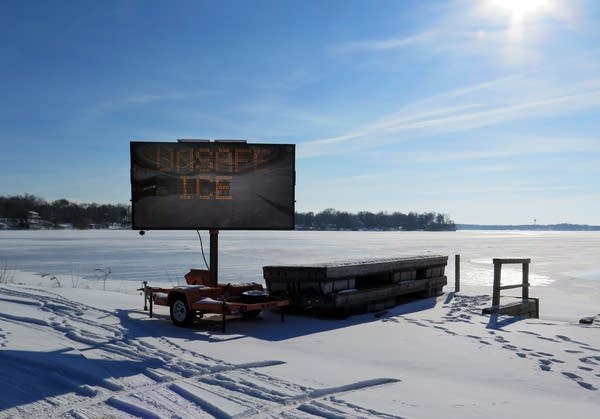Dangers of the season: thin ice, carbon monoxide

Recent deaths from carbon monoxide and thin ice are a reminder that wintertime hazards in Minnesota take lives every year — and that many are preventable.
The state's latest carbon monoxide death happened Saturday in a St. Louis County cabin. A 46-year-old man and his dog died, a generator was found running in the building.
The death was a reminder for Denice Johnson of Akeley, Minn., of how quickly carbon monoxide can kill. It's been almost two years since her son Jared left for an overnight ice fishing trip with friends to Leech Lake. The night started successfully, Jared even sent his parents a photo of a nice fish he caught. But tragedy was close by, carbon monoxide from propane heaters was building up in their camper parked on the lake ice.
Denice Johnson says sometime in the early morning hours of Jan. 17, 2016, the fumes killed her son, who was 34.
Create a More Connected Minnesota
MPR News is your trusted resource for the news you need. With your support, MPR News brings accessible, courageous journalism and authentic conversation to everyone - free of paywalls and barriers. Your gift makes a difference.
"I can't even begin to tell you how it's changed our life," said Johnson. "He left behind children who no longer have a dad. He left behind parents that are devastated. Sisters that are devastated. Nieces, nephews and a passel of friends."
Johnson has spoken publicly about the event, appearing at a state public safety department news conference earlier this year. Then as now, her main message is to protect yourself from the deadly gas, whether at home, in a tent, or an ice fishing house.
"I would hope and pray that every fisherperson heeds my warning," said Johnson. "How horrible it is to lose someone in that manner. When it could have been prevented by a small thing as a carbon monoxide detector."
She said the ice house had a detector, but it was not working.
Keeping safe is simple, officials say, especially when measured against the almost unending pain an accident causes friends and family.
While most carbon monoxide alarms in the state are in working condition, it's not uncommon to find one that's not, the state health department says.
"It is important to test the alarm periodically," said Dan Tranter an indoor air expert with the Minnesota Department of Health. "That will tell you if the siren works and the electric circuitry is connected. If you're not sure, replace it every five years."
Fourteen people die on average each year in Minnesota from carbon monoxide.
A cold front scheduled to arrive later this week will heighten concerns about carbon monoxide poisoning. Tranter said injuries and deaths caused by carbon monoxide typically increase as winter temperatures fall.
But the anticipated cold outbreak should help decrease the dangers of another wintertime hazard, thin ice.
So far this winter, five people have died when they broke through the ice, more than the three or so fatalities the state has averaged the past ten seasons.
Weather has been the main factor, said Lisa Dugan with the Minnesota Department of Natural Resources. There was an early freeze up in November, but then the weather changed.
"Early December there was above freezing temperatures for so long that any of that ice that had already formed was compromised," said Dugan. "And it wasn't that nice, solid, clear ice that we like to see people recreating on."
Dugan said increasingly, all-terrain vehicles or ATVs, seem to be involved in thin ice accidents. Four of the five deaths so far this winter season were linked to ATVs. She said one reason for the increase is because ATVs are getting bigger.
"With the increased popularity of side-by-side ATVs, and the increased weight of those ATVs, there has to be enough solid ice to support that," said Dugan.
The DNR says 5 to 7 inches of ice are needed to support an ATV. Even though colder weather is forecast, the agency said it's a good idea to check ice thicknesses throughout the winter, no matter the temperature.